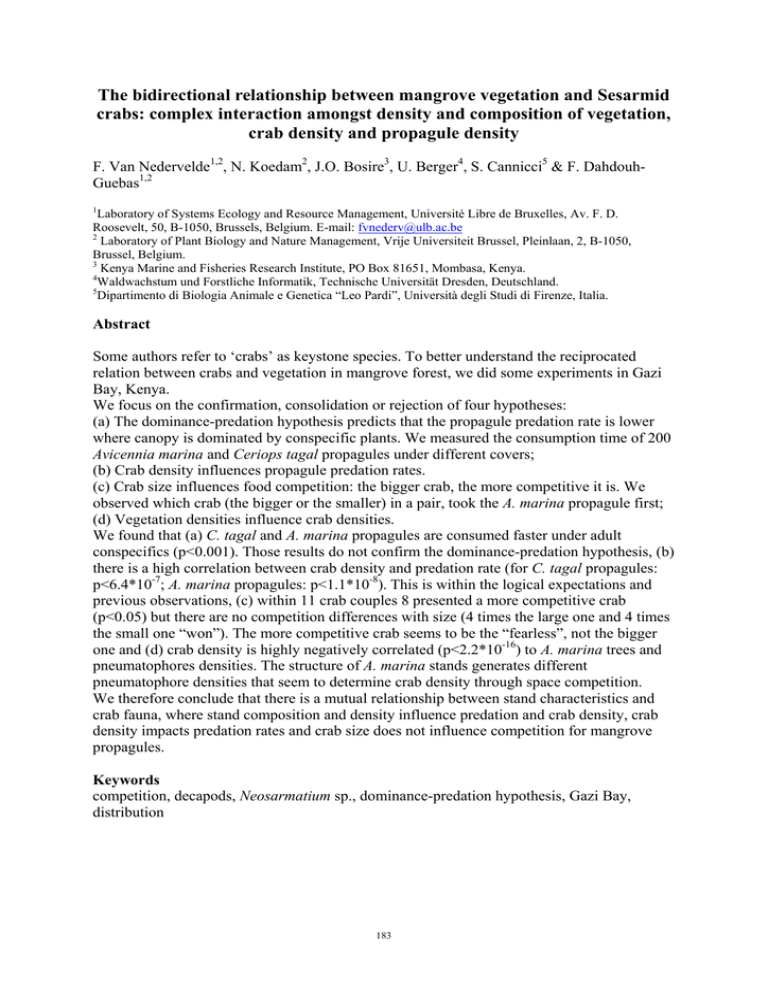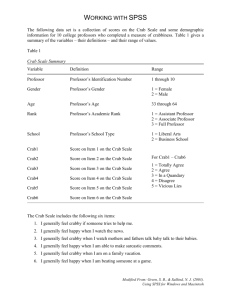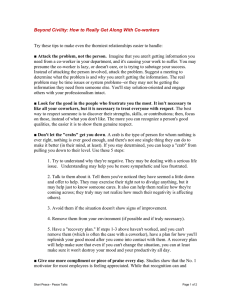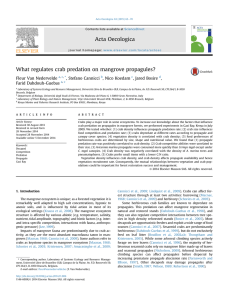The bidirectional relationship between mangrove vegetation and Sesarmid
advertisement

The bidirectional relationship between mangrove vegetation and Sesarmid crabs: complex interaction amongst density and composition of vegetation, crab density and propagule density F. Van Nedervelde1,2, N. Koedam2, J.O. Bosire3, U. Berger4, S. Cannicci5 & F. DahdouhGuebas1,2 1 Laboratory of Systems Ecology and Resource Management, Université Libre de Bruxelles, Av. F. D. Roosevelt, 50, B-1050, Brussels, Belgium. E-mail: fvnederv@ulb.ac.be 2 Laboratory of Plant Biology and Nature Management, Vrije Universiteit Brussel, Pleinlaan, 2, B-1050, Brussel, Belgium. 3 Kenya Marine and Fisheries Research Institute, PO Box 81651, Mombasa, Kenya. 4 Waldwachstum und Forstliche Informatik, Technische Universität Dresden, Deutschland. 5 Dipartimento di Biologia Animale e Genetica “Leo Pardi”, Università degli Studi di Firenze, Italia. Abstract Some authors refer to ‘crabs’ as keystone species. To better understand the reciprocated relation between crabs and vegetation in mangrove forest, we did some experiments in Gazi Bay, Kenya. We focus on the confirmation, consolidation or rejection of four hypotheses: (a) The dominance-predation hypothesis predicts that the propagule predation rate is lower where canopy is dominated by conspecific plants. We measured the consumption time of 200 Avicennia marina and Ceriops tagal propagules under different covers; (b) Crab density influences propagule predation rates. (c) Crab size influences food competition: the bigger crab, the more competitive it is. We observed which crab (the bigger or the smaller) in a pair, took the A. marina propagule first; (d) Vegetation densities influence crab densities. We found that (a) C. tagal and A. marina propagules are consumed faster under adult conspecifics (p<0.001). Those results do not confirm the dominance-predation hypothesis, (b) there is a high correlation between crab density and predation rate (for C. tagal propagules: p<6.4*10-7; A. marina propagules: p<1.1*10-8). This is within the logical expectations and previous observations, (c) within 11 crab couples 8 presented a more competitive crab (p<0.05) but there are no competition differences with size (4 times the large one and 4 times the small one “won”). The more competitive crab seems to be the “fearless”, not the bigger one and (d) crab density is highly negatively correlated (p<2.2*10-16) to A. marina trees and pneumatophores densities. The structure of A. marina stands generates different pneumatophore densities that seem to determine crab density through space competition. We therefore conclude that there is a mutual relationship between stand characteristics and crab fauna, where stand composition and density influence predation and crab density, crab density impacts predation rates and crab size does not influence competition for mangrove propagules. Keywords competition, decapods, Neosarmatium sp., dominance-predation hypothesis, Gazi Bay, distribution 183




